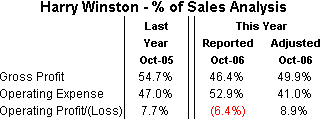IDEX Online Research: Harry Winston Jewelers Didn’t Lose Money in Q3
January 07, 07
Contrary to its press release, Aber Diamond’s Harry Winston retail division didn’t lose $3.5 million from operations in the third quarter ended October 2006. After adjusting for unusual items, Harry Winston earned just over $4.8 million, a 53 percent increase in operating profits over the same period a year ago.
A swing of $8.3 million between “reported” profits (a loss in Harry Winston’s case) and “actual” profits is a huge swing for any company. What was behind this reporting disparity related to operating profits?
Essentially, two factors caused “reported” profits to differ dramatically from “actual” profits:
- Obsolete merchandise – Certain inventory that was on hand when Aber acquired its first stake in Harry Winston (April 2004) was finally sold off at a significant discount in the October quarter. The gross margin including the sale of this obsolete merchandise (more than two years old) was 46.4 percent. Excluding the obsolete goods, Harry Winston would have reported a gross margin of 49.9 percent. While it is arguable that every company has obsolete merchandise – that is a “normal” cost of doing business – the deep discount associated with the sale of these obsolete goods was highly unusual and appears to be a one-time event.
- Stock-based compensation – This new GAAP accounting requirement has been haunting companies since it was implemented recently. GAAP requires that companies expense certain stock-based costs immediately. In our opinion, this presents a misleading picture of the financial health of a company. However, in accordance with GAAP, Harry Winston incurred a non-cash charge of $6.3 million related to stock-based compensation triggered by the acquisition of the remaining portion of Harry Winston. In September 2006, Aber purchased the remaining portion of Harry Winston - 47.17 percent - for $157.2 million. It had previously paid about $85 million for about 51 percent of Harry Winston in April 2004. The remaining 2 percent of Harry Winston had been purchased by Aber between April 2004 and September 2006.
As a result of these unusual charges, Harry Winston was forced by GAAP accounting to report a large operating loss for its third quarter. In our opinion, GAAP results do not present a fair and reasonable statement of Harry Winston’s financial health in the October 2006 quarter. A fairer presentation would have been a non-GAAP statement of results which would have shown the significant increase in operating profits.
We have prepared a table below which presents a fair and reasonable comparison of Harry Winston’s financial results for the October quarter – 2006 versus 2005. The table below summarizes the differences between “reported” results and “actual” results. “Actual” results are comparable on a year-to-year basis.
|
|
Harry Winston – Highlights of October Quarter
Financial results were solid for Harry Winston in the three-month period ended October 2006. The following are financial highlights:
- Sales – Sales rose by 32 percent to $54.5 million. This is a particularly impressive comparison, especially since the sales comparison was against a tough 18 percent gain in the prior year. Sales were driven by four key factors:
- Strong same-store sales gains in existing units (management does not release same-store sales numbers).
- Better-than-expected sales gains in new stores, especially in the U.S. and Japan.
- Solid sales of new merchandise.
- Strong demand for Harry Winston timepieces.
By geographic region, sales gains in the U.S. were the strongest, as the table below illustrates.
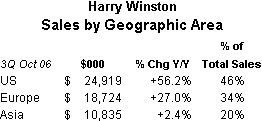 |
Harry Winston operated 12 stores in the October 2006 quarter versus 8 units last year.
- Gross Margin – 49.9 percent vs. 54.7 percent - While Winston’s gross margin was down year-over-year, it was about in line with management’s goal of about 50 percent. Three factors helped boost the company’s gross margin from prior quarters this year: better buying, a more favorable merchandise mix, and new pricing. The graph below summarizes margin trends over the past eleven quarters.
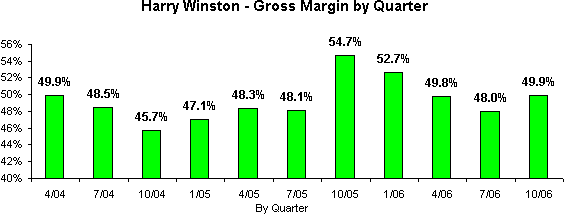 Source: Company reports |
- Operating Costs – 41.0 percent vs. 47.0 percent - The reported operating cost ratio was 52.9 percent, and it consisted of the large one-time charge for stock-based compensation of $6.3 million. Other factors which drove up the dollar value of operating costs included an increase in salaries and benefits, especially related to new stores; advertising and selling expenses; occupancy costs; “other” expenses; and, professional fees.
- Operating Margin – 8.9 percent vs. 7.7 percent - The reported operating margin was a loss of 6.4 percent. However, after eliminating unusual items, the actual operating margin was a strong 8.9 percent. The company’s long term goal is to achieve an operating margin of about 10 percent for Harry Winston. The graph below summarizes Harry Winston’s operating margin since its acquisition.
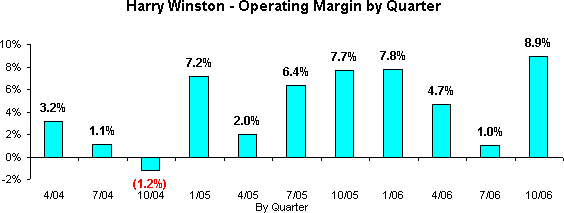
Source: Company reports
Harry Winston Highlights Since Being Acquired By Aber
For the first time in many years, the management of Harry Winston is focusing on building the business. Prior to Aber’s initial acquisition of about 51 percent of Harry Winston in 2004, family members had been quarrelling among themselves, and the business suffered.
Since Aber’s acquisition of Harry Winston, its sales and profits have climbed steadily. The following are highlights of Harry Winston’s operations since Aber’s initial acquisition.
· New Stores – When Aber initially purchased an interest in Harry Winston in April 2004, there were six stores. In less than three years, the number of Harry Winston stores had more that doubled to 13 units, including the following:
o New York (Fifth Avenue)
o Honolulu
o Bal Harbour
o Beverly Hills
o Las Vegas
o Dallas (opened November 2006)
o Paris
o London
o Geneva
o Tokyo Ginza
o Tokyo Omotesando
o Osaka
o Taipei
· Sales Gains – The following graph illustrates sales trends since the first quarter of 2004. Sales have been driven by increased demand in existing markets as well as new stores in new markets.
Because of the seasonality of Harry Winston’s business, we have color-coded each quarter separately. For clarity, readers should look at the trend based on the color of the bar. Each quarter, on a year-to-year basis, has shown a solid increase
in sales.
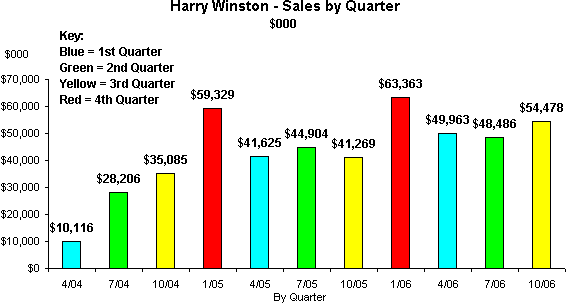
Source: Company reports
· Profit Gains – The following graph illustrates profit trends since the first quarter of 2004. Because of the seasonality of Harry Winston’s business, we have color-coded each quarter separately. For clarity, readers should look at the trend based on the color of the bar. Profits on a year-to-year basis have not always shown positive comparisons due to new store opening costs and other operating costs that fall outside of the jeweler’s usual seasonal expenses.
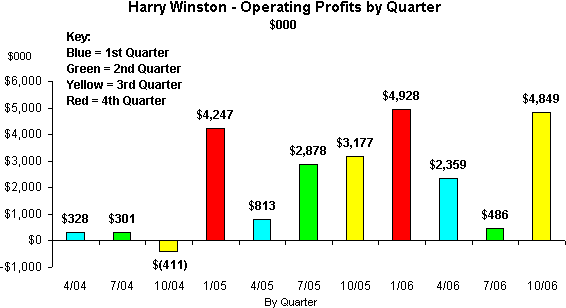 Source: Company reports |
· Harry Winston Growth Targets – At its annual shareholder meeting in 2006, management articulated its growth targets through 2008, as follows:
o Sales +15-20 percent annually (versus an industry average for high-end jewelers of +10-15 percent annually)
o Gross margin of 51 percent in 2006, increasing by one percentage point annually. Currently, Harry Winston’s gross margin is below the industry average of 55-65 percent for high-end jewelers.
o Operating expense ratio of 45 percent in 2006, with a decline of one percentage point annually. Currently, Harry Winston’s operating cost ratio is at the low end of the industry average of 42-50 percent.
o Inventory turn of 0.7x, rising to 1.0x or higher. The industry average among high-end jewelers is less than one turn annually.
o Operating margin of 10 percent over the longer term.
o New stores will be added at the rate of two to three annually on a global basis. In the U.S., the company has indicated that it plans a new store in Chicago in 2007, with other stores planned for Japan.
· “We are not everyone’s jeweler” – Tom O’Neill, president of Harry Winston, made this statement at the company’s annual shareholder meeting. He went on to say, “There is an air of formality and exclusivity that sets us apart from other would-be luxury jewelers. Harry Winston is not a minimalist, and the salon interiors reflect the richness and the glamour of diamonds. Our new store design incorporates high ceilings and abundant light, a sense of calm and grandeur, the restrained luxury of the original design.”
Here’s why Harry Winston isn’t everyone’s jeweler, based on the price points of some of its key product development efforts:
o Diamond engagement rings start at $15,000. This compares to the industry average of $2,750 for a diamond engagement ring. Blue Nile’s average engagement ring sells for $5,700, and Tiffany’s average ticket for a diamond engagement ring is $10,400.
o Bridal jewelry collections retail for up to $100,000 and higher.
o Core jewelry collections retail for up to $250,000.
o Statement jewelry diamonds begin at $250,000.
o Designer jewelry can be priced into the millions.
· Harry Winston is luxury – Management recently referred to a new Luxury Index survey conducted by the New York-based Luxury Institute in which Harry Winston was cited as the most prestigious purveyor in its segment as rated by America’s penta-millionaires who gave their assessment of 23 jewelry brands around the world. Harry Winston finished first place in four critical metrics of luxury brand prestige:
o Superior quality
o Uniqueness and exclusivity
o Social status
o The ability to make customers feel the special thing that one feels throughout the entire customer luxury experience.

